The best way to appreciate sculptures.
When a sculpture is placed in front of our eyes, we first need to see the complete picture of the work. We don’t know the author yet, but from the sculpture, we can intuitively see its exquisiteness and the professionalism of the carver. The first way to appreciate this work is to give affirmation, and the second is to understand its ins and outs and explore the author’s inner thoughts based on the overall shape of the work and its decoration. Through our imagination and in-depth thinking, giving the product the thoughts, ideas, and vitality that we really want to express is the best way to appreciate sculptures.
The Veiled Virgin
The Veiled Mary is a marble bust depicting the veiled image of the Virgin Mary. It was carved by the famous Italian sculptor Giovanni Strazza. Strazza had a great passion for sculpture since he was a child. The Virgin Mary is his classic creation.
Artist: Giovanni Strazza
Year: Unknown, probably early 1850
Type: Carrara Marble

The Veiled Virgin, also commonly known as the Veiled Virgin, was sculpted by Italian sculptor Giovanni Strazza in Rome. This sculpture is mainly a bust of the Virgin Mary. Tracing the history of this work, we can find that Strazza received such a beautiful sculpture of the Virgin Mary in Newfoundland in 1856, and the statue was later kept in the cathedral next to St. John’s Catholic Cathedral. Until 1862, when Bishop Morlock presented the Veiled Virgin to Sister Mary Magdalene O’Shaughnessy, the abbess of the convent, the bust of the Virgin Mary remained in St. John’s Cathedral. The displays in the square are taken care of by the Sisters.
In Strazza’s era, marble-veiled busts were more popular, and the veiled virgin also symbolized the new Italy under the Risorgimento, symbolizing unity and purity. In fact, this kind of veiled figure statue appeared and became popular as early as more than a hundred years ago in the 1700s, but why was it so popular in the Italian sculpture industry in the 19th century? The main reason is that the effect of this kind of statue can prove The creator has profound sculpture skills. The veil is originally a light and thin fabric. How to carve it on marble is very difficult just to imagine the idea, let alone actually present it on a stone. Therefore, turning this difficult and challenging carving into reality has allowed Italian sculptors to show their superb and ingenious design and carving skills.
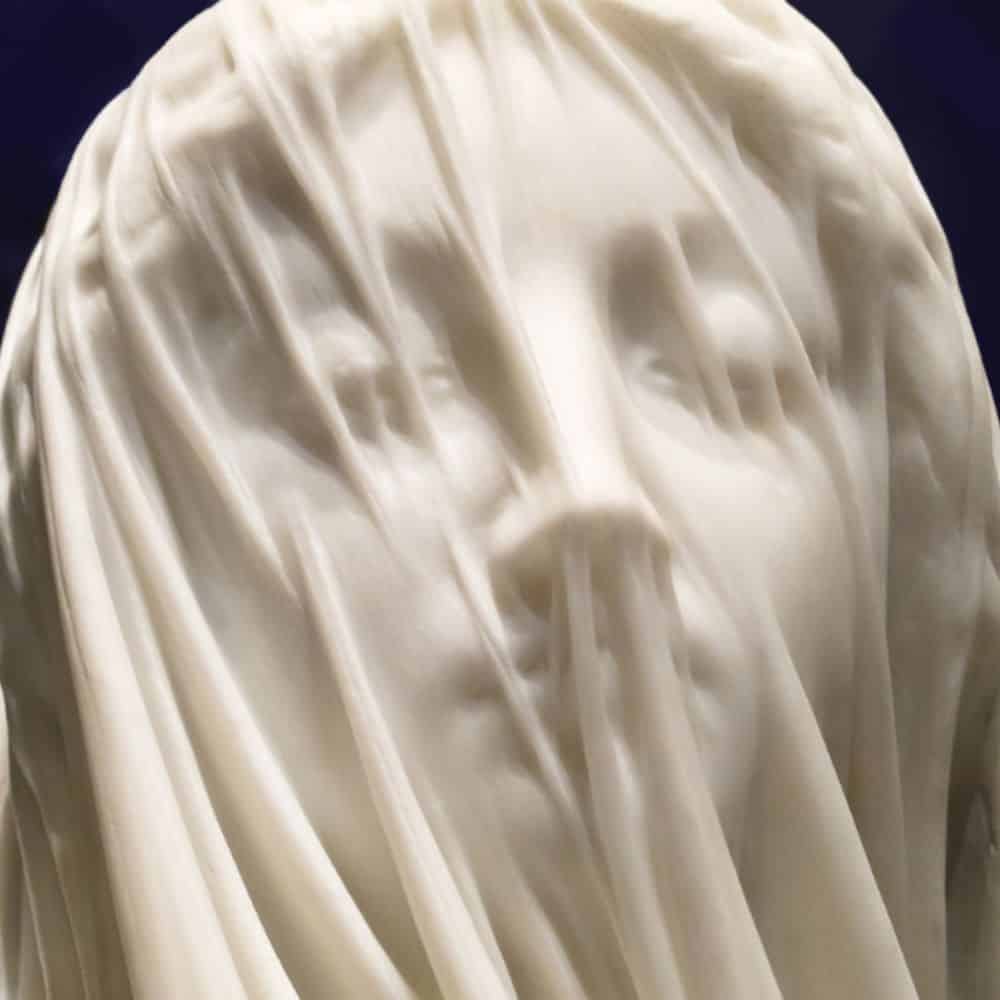
The veiled virgin hides the face and part of the body of the Virgin Mary behind the veil. Mary’s head is slightly lowered, her eyes are closed, and the corners of her mouth are slightly curved. Her entire facial expression is calm and calm. Modesty fully reveals Maria’s beauty and confidence, and the veil on her face also looks very real and light, showing the transparency and natural folds of the real veil, making people unable to believe that it is actually made of marble carved out. When we see this bust of the Virgin Mary, we can feel her great love and faith, which brings peace and calm to our hearts and gives us the power of love all over our bodies.
A Veiled Vestal Virgin
Author: Rafael Monti
Time: 1847
The Veiled Virgin of Vesta was created by the Italian sculptor Raffaelle Monti. Monti’s father is a famous sculptor. Monti studied under his father’s trade and later created “Vestal Virgins” and “The Bride” and a series of works.
The Masked Virgin of Vista is the most exquisite and famous of the works of art created by Rafael Monti. The statue is currently housed in the Watts Estate in England.
This statue is a sculpture of an ancient Roman priestess. They were responsible for guarding the goddess Vesta, so they were also called Vesta virgins. These girls were selected through layers of screening to serve the goddess of the hearth. His duty is to take care that the holy fire lit on the Altar of the West will never be extinguished.
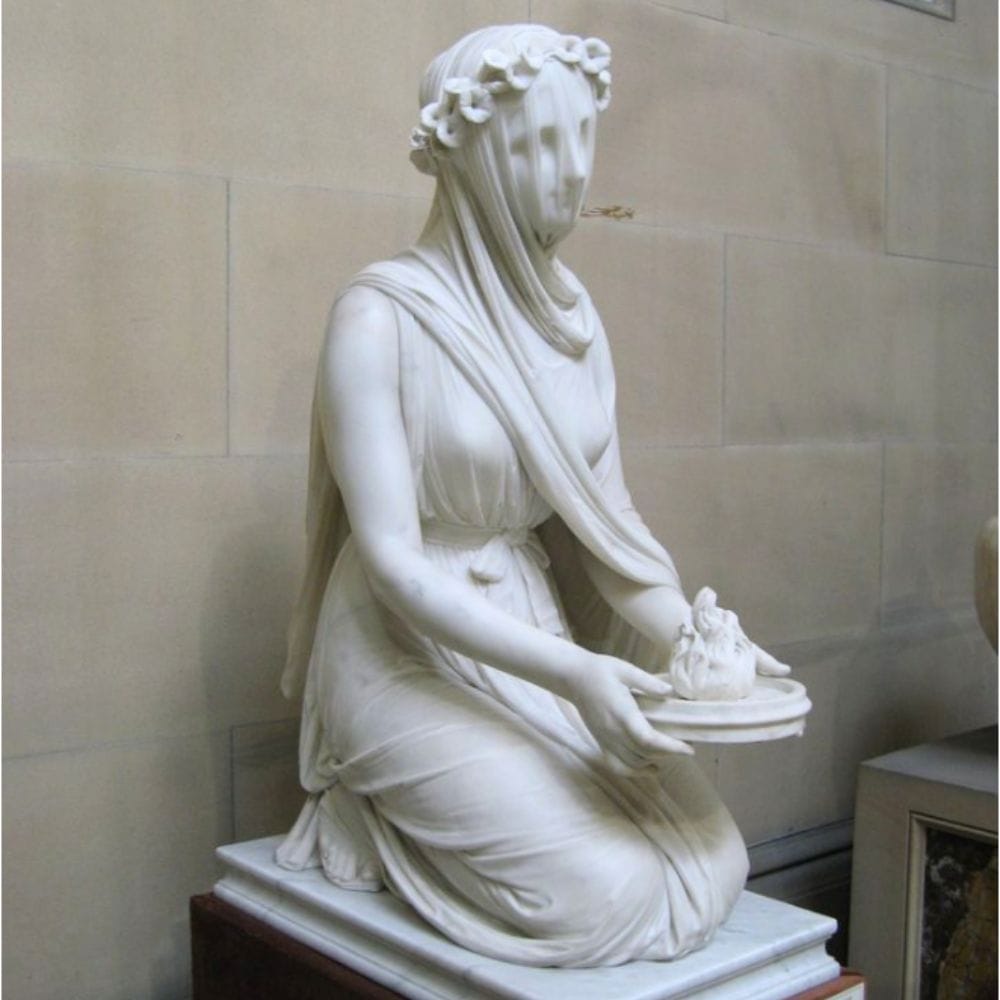
The most well-known thing about this sculpture is that in the 2005 movie “Pride and Prejudice”, the heroine Elizabeth went to Darcy Manor for the first time and saw this statue of the Virgin of Vesta in a room full of sculptures. Make eye contact with it.
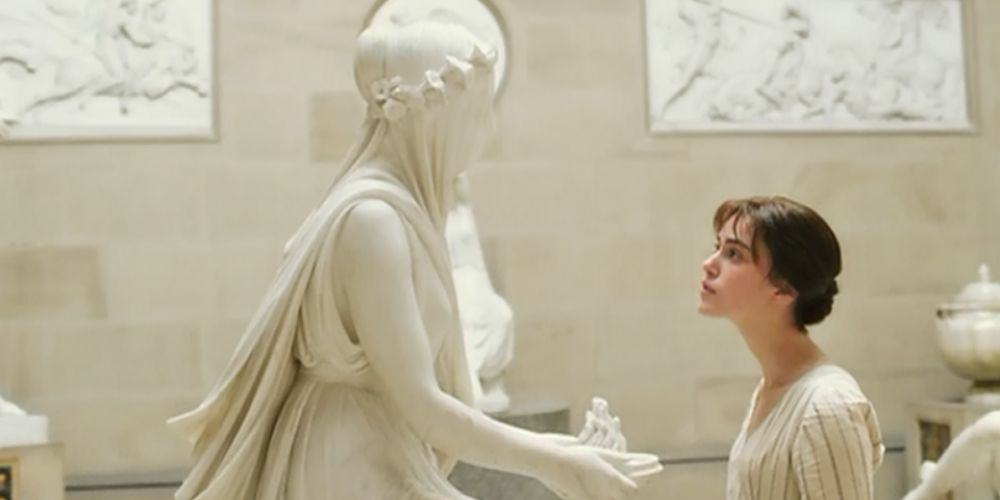
The priestess, Vestal Virgin, is sitting there with her eyes closed. The veil on her head is as thin as cicada wings and is looming. On the one hand, it is unbelievable that this is a veil carved on marble, and on the other hand, it also marvels at the creator’s superb skills. Using advanced carving techniques, the priestess’s veil and costume are so complex and lifelike that you can even see sunlight and shadows through the veil. The calmness on the virgin’s face is very attractive, and the space between her and the entire surrounding environment becomes quiet.
“The Bride”-marble bust of a veiled girl
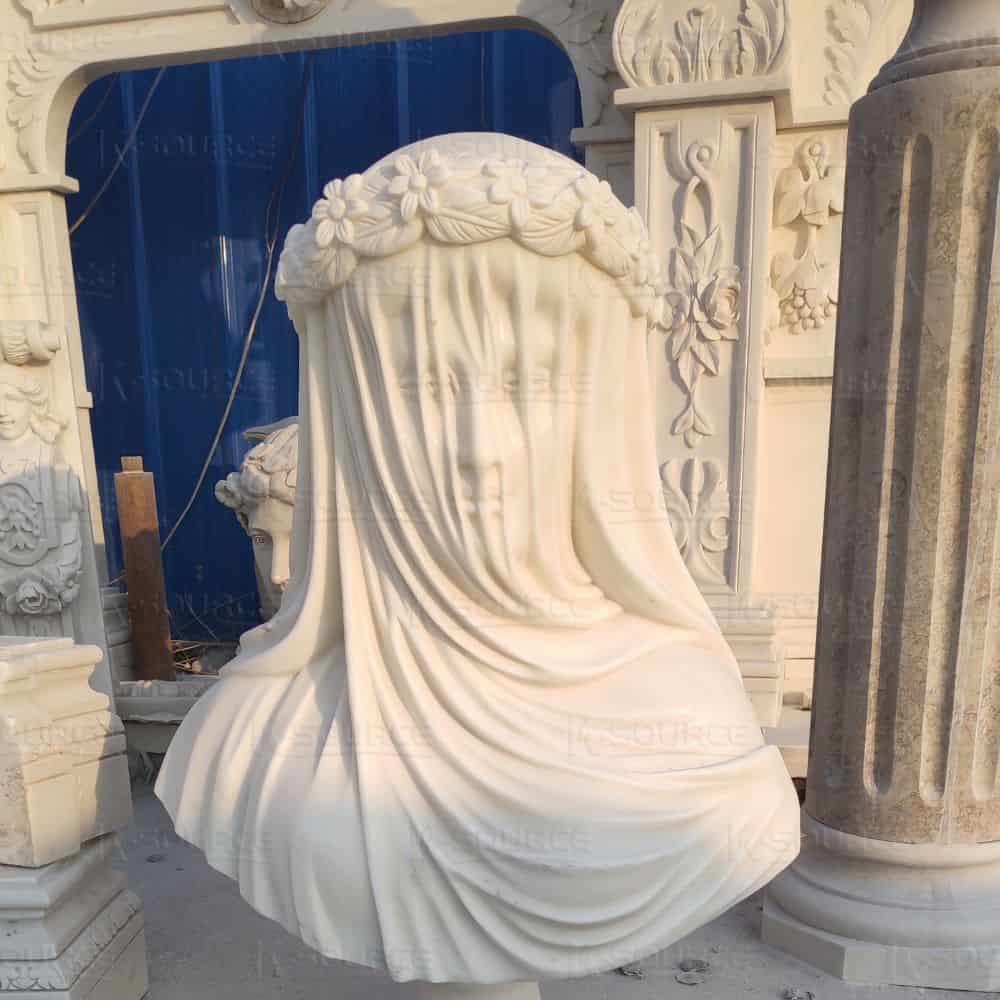
Author: Raffaello Monti
Monti used his carving skills to shape marble into a living statue. This marble bust of the bride also uses marble to reflect the soft veil and fully reveals the beauty of the bride, which is contagious.
Veiled Christ
Author: Giuseppe Sanmartino
Time: 1753, Baroque period
In the San Severo Chapel in Naples, Italy, there is a sculpture that is called a miracle of art: the Veiled Christ.
Italian aristocrat Raimundo di Sangro originally commissioned the sculpture from sculptor Antonio Corradini to create a realistic, life-size marble statue of Christ covered with the shroud. Antonio Corradini made a life-size clay model, but he died soon after. The commission was then given to Giuseppe Sanmartino, who abandoned Corradini’s earlier model and produced a new work with the dead Christ lying on a sofa, Covered in tulle that molded perfectly to the shape of his body. Almost everyone who sees this sculpture will involuntarily exclaim, marveling at its exquisite craftsmanship and precise presentation of details.
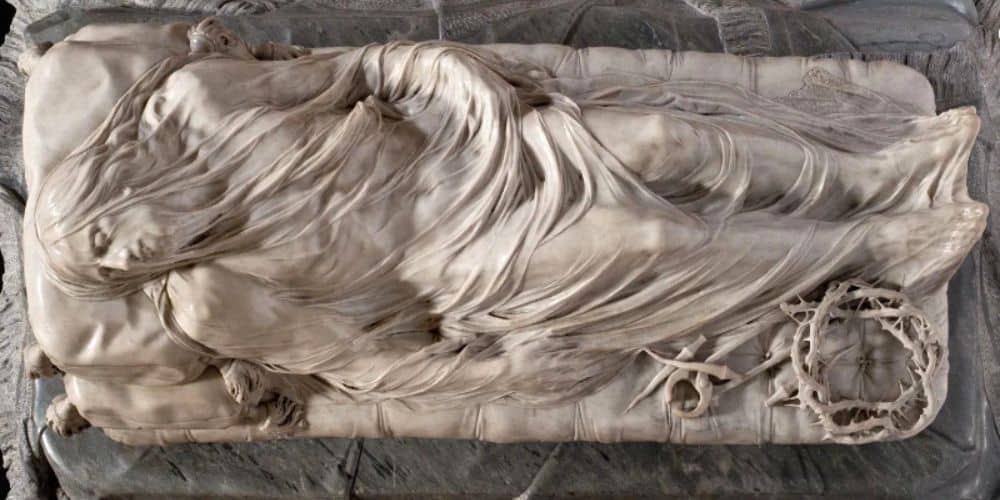
This statue vividly depicts the body of Christ. His body is covered with a transparent tulle made of a whole piece of white marble. Through the tulle, you can see the pain and torture on Christ’s face and body, and his hands are covered with The holes where the nails were driven are still clearly visible, and at the feet are placed the tongs used to torture Christ, the thorny crown and the pulled out nails.
The extremely fine carving details record the sufferings of Christ on the one hand and show people the reality of death. On the other hand, the fake gauze adds a mysterious atmosphere to this statue, which can make people temporarily forget their sorrow and marvel at the beauty of the surroundings.
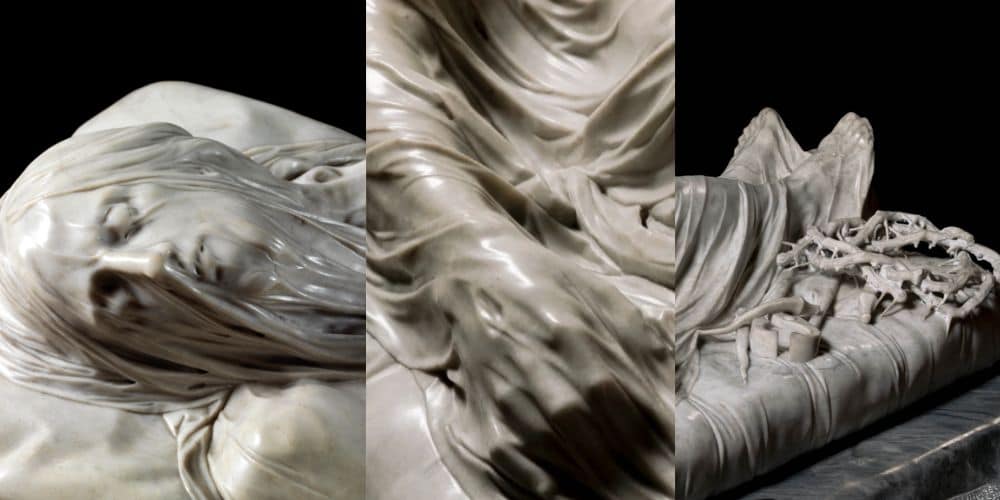
Regarding the masked statue of Christ, there is also a very famous legend about the veil on Christ. It is said that this veil is a real piece of gauze that Prince Raimundo di Sangro used his alchemy to create in Montenegro. After covering the face of Christ with a veil, special chemical reagents were used to transform it into marble. For a long time, people believed that this happened. This legend shows the unique mastery of Giuseppe Sanmartino’s carving: craftsmanship and superb level of detail.
Modesty
or the truth called chastity or blinding
Author: Antonio Corradini
Time: 1752
Period: Rococo period
This statue is called Modesty or Chastity or Veiled Truth, also located in the San Severo Chapel in Naples, Italy. It was commissioned by Antonio Corradini for his work from Raimundo di Sangro A statue carved by his mother in memory of his mother, Princess Cecilia, who died when he was one year old.
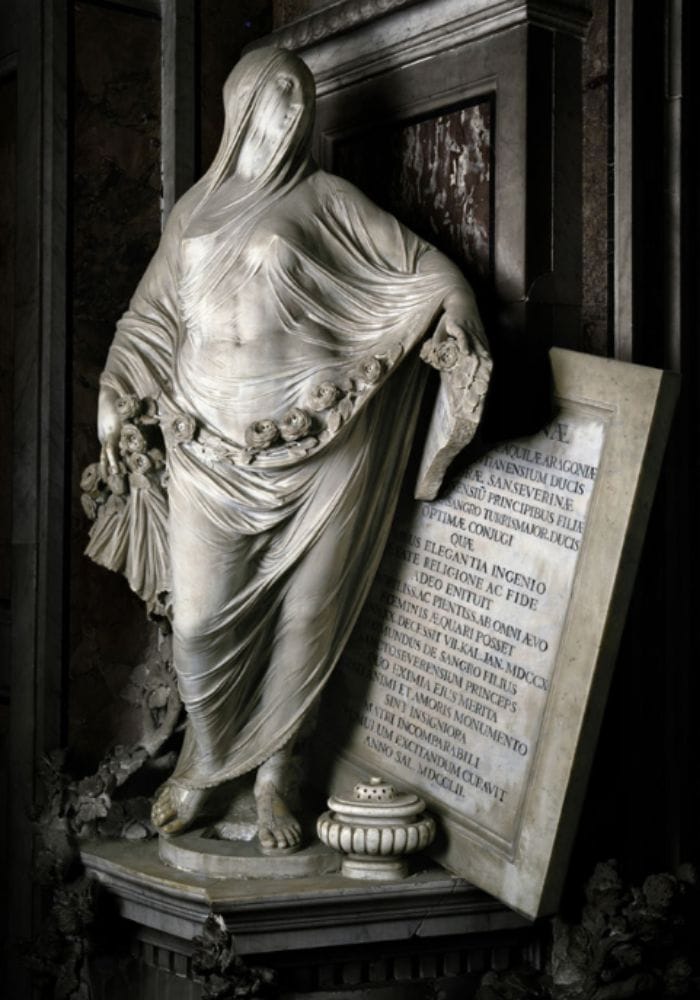
The Modesty Statue is a sculpture of a young woman covered with a layer of gauze. Her face is turned away from the crowd. The thin veil covers her eyes. She looks blankly into the distance. She leans on the broken tombstone with her left hand and gently lifts the inlay with her right hand. There is a veil of roses, and at the foot is the tree of life carved out of marble. The roses on her waist show the nobility of Princess Cecilia, and the broken tombstone reveals her short life. The woman is exposed but is completely protected by a veil. Her natural and soft body is full of fluidity and artistic appeal. Gazing at such statues makes one forget the passage of time.
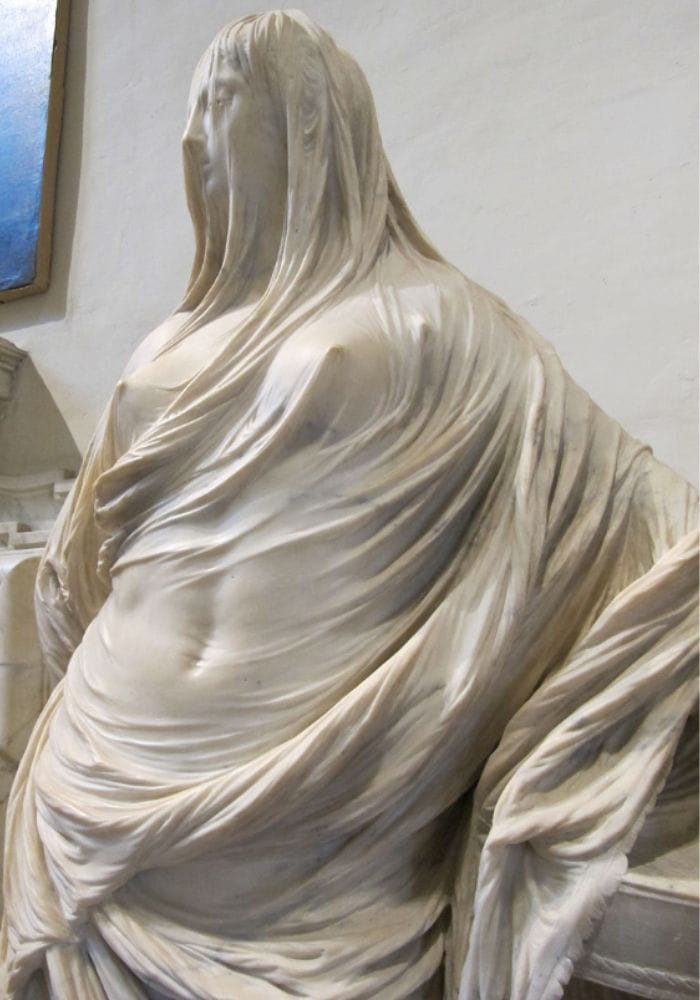
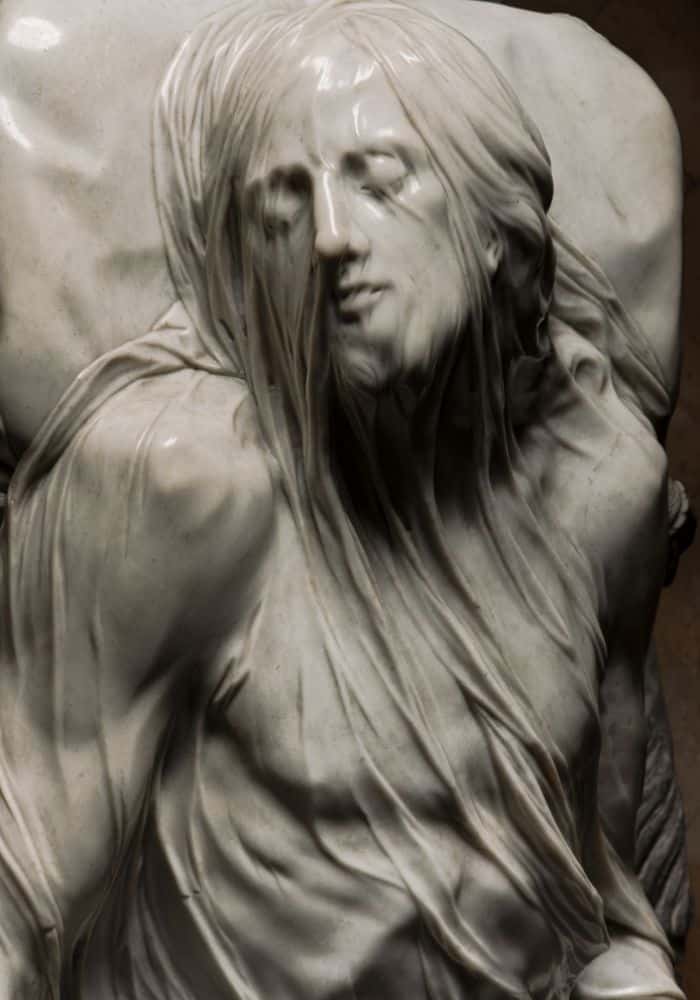
” Modesty” and “Veilted Christ” are two sculptures completed by Corradini for the Church of San Severo, two of a series of ten statues of virtues. The veiled female image embodies modesty and chastity and is also considered a representative of wisdom; the veiled Christ tells the story of people’s emphasis on Christian faith. Corradini’s skillful handling of marble materials can be seen in Corradini’s works. The lightness of the seemingly heavy cloth on the human body gradually becomes lifelike. Only a skilled sculptor can create shapes on a hard marble material. Create such a character.
Veiled Rebecca
Author: Giovanni Maria Benzoni
Creation time: 1864, neoclassical period
The Veiled Rebecca is a classic of neoclassicism popular in the 19th century. Benzoni was a pursuer and admirer of veiled statues. The Veiled Rebecca, a trompe l’oeil sculpture carved out of marble by Benzoni, shows a scene from the Hebrew Bible in which Rebecca covers herself with a veil as she goes to meet her future husband. The most noteworthy aspect of this statue is the misaligned visual effect of the transparent veil and the figure-hugging dress.
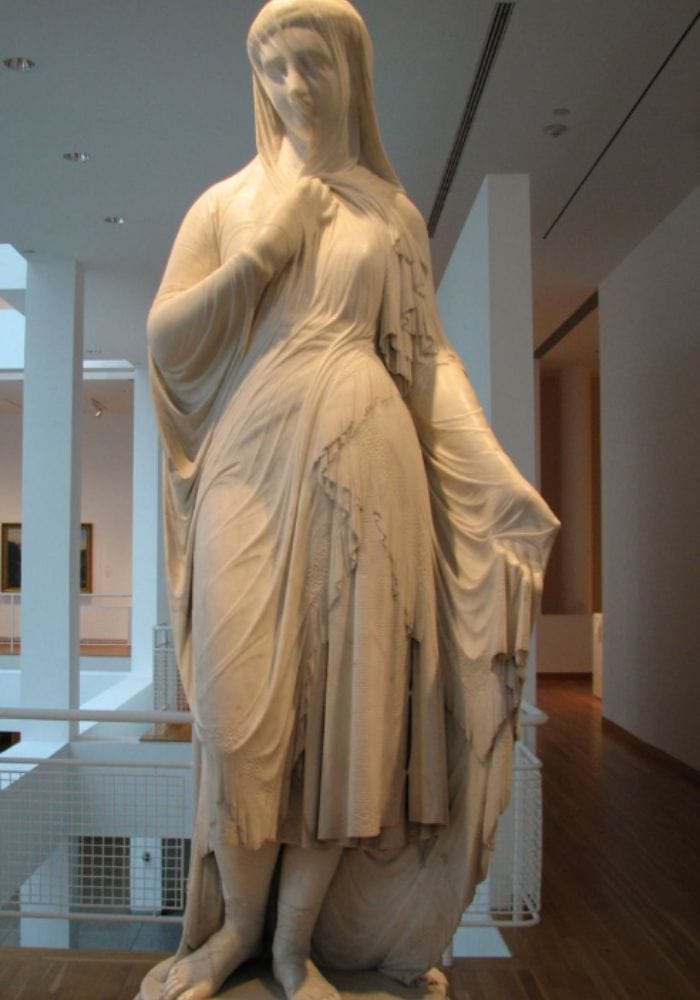
When Rebecca saw her husband Isaac for the first time, she lowered her head slightly, her gaze slightly downward, holding the veil tight with her right hand, showing dignified modesty, while her other hand was partially Open up in a welcoming gesture. A thin, fringed veil fell over her head, face, and shoulders, falling irregularly at her feet. The translucent dress further accentuated the contours of her body. The marble has been carved into the fabric that hugs the body to bring the Rebecca statue to life while also highlighting the sculptor’s artistry in visual dislocation.
It is said that wearing the veil can be traced back to the ancient Roman period. People usually look for women with prominent family backgrounds and steadfastness to guard the holy flame for life. Usually, when the ceremony is held, these women will cover themselves with a veil, which is not only a symbol of their identity but also a reverence for the gods. It is also a ritual at that time. These women infected the people around them with their beauty and purity. They had a profound impact on society at that time and are well-known to us in modern society. At this point, we have learned about the external environment and central idea of the work, and the beauty that the author wants to express can be easily expressed. It can be imagined that under the background of the times, the author used this kind of work to express his love for life and his yearning for purity and beauty, and expressed it in the form of sculptures. Through his exquisite carving skills, he shows us such a unique work of art and its mysterious beauty.
The veiled marble statue is usually carved from high-quality marble. Its face and body appear to be partially obscured by a flowing transparent curtain. The expression and figure of the figure under the veil are looming, and the tulle clings to the body and face for a realistic feel. In fact, it is a visual effect achieved through the use of translucent marble and clever composition design, adding beauty and artistic flavor to the entire sculpture.
Now, you are invited to admire the veiled girl works carved by our K-SOURCE.




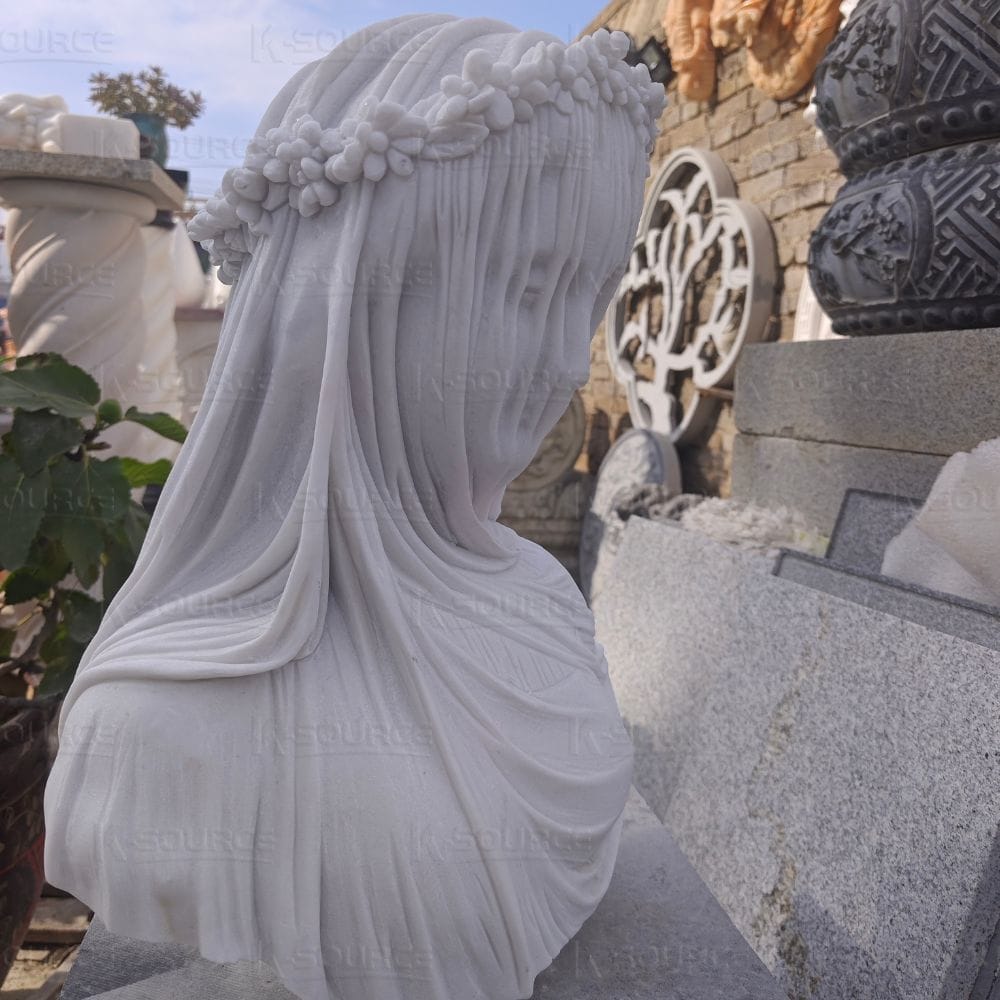
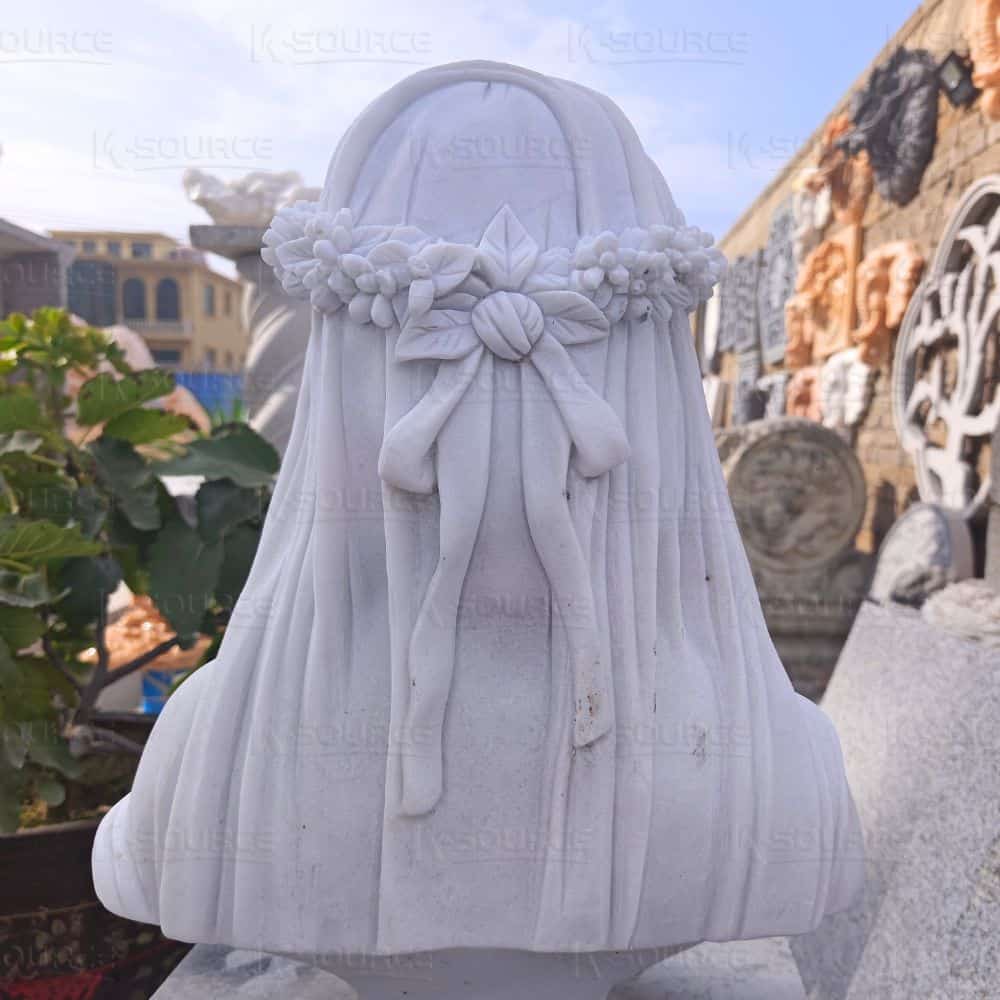

Below is the data about the K-SOURCE veiled girl bust statue.
| Name: | The Veiled Virgin |
| Brand: | K-SOURCE |
| Category: | Marble Sculpture |
| Size: | Height:55 cm |
| Material: | Natural Marble |
| Weight: | About 30 KG |
| Transportation Method: | Air Transportation |
| Shipping Time: | 7-8 days |
| Service: | Support Customization |
| MOQ: | 1pc |
| Duration: | Inventory |
| Packaging: | Sturdy Wooden Box |
Conclusion:
Veiled marble statues and bust marble sculpture products are my favorite decorative items. Whether as a collectible or a display piece with high application value, careful layout, and strategic arrangement can add a unique artistic atmosphere to your yard and home. If you have an idea for beautifying your space with a veiled statue, don’t hesitate to contact us. We can accurately capture the details and core of the sculpture, either to the original scale or customized to any other size you need.


Pingback: MyBlog
Pingback: compare prices generic enclomiphene online without prescription
Pingback: kamagra sans ordonnance et livré la nuit
Pingback: order androxal price discount
Pingback: buying flexeril cyclobenzaprine purchase line
Pingback: dutasteride USA discount
Pingback: buy gabapentin lowest price viagra
Pingback: get fildena cheap drugs
Pingback: how to order itraconazole generic pharmacy usa
Pingback: buying avodart generic side effect
Pingback: discount staxyn generic pharmacy in canada
Pingback: purchase xifaxan overnight no rx
Pingback: discount rifaximin generic online usa
Pingback: kanadská lékárna kamagra online